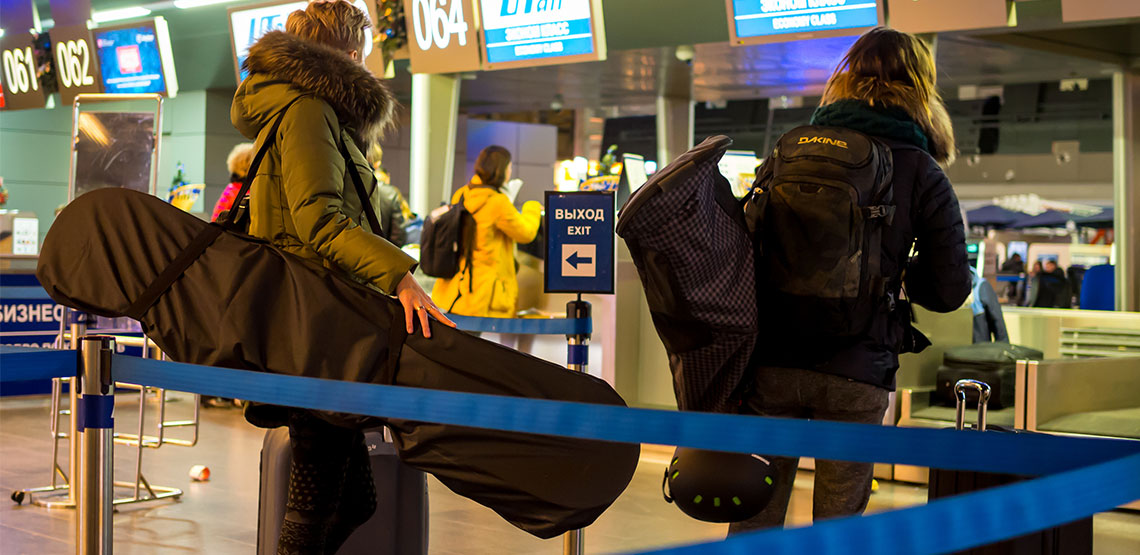Skis, Saxophones & Strollers: Tips for Flying with Oversized or Odd Items
Avoid Unpleasant Surprises
When you’re getting ready to fly out of town on a trip, packing the usual items like clothes and shoes is simple, but what happens if you have to bring an odd-shaped, large or heavy item?
There are all kinds of things you might need to bring that can cause problems, from travel strollers to musical instruments to sports equipment like golf clubs or skis. If you don’t plan ahead of time, you might get charged a hefty fee for flying with skis and the like. Or, you may not be able to fly with the item at all.
Of course, all airlines don’t follow one set of rules, making things even more complicated — each has their own distinct policy. But the good news is that a little knowledge about flying with awkward items can help eliminate worries and stress, and perhaps save you some money.
Tips for Flying with Awkward Items
Sporting gear is one of the most common awkward or large-sized items passengers fly with. If you’re embarking on an adventurous vacation and want to bring your own equipment, most airlines will allow you to check it in as part of your baggage allowance, or as additional baggage for an extra fee.
If you’re traveling with golf clubs, you can check them as long as they’re stored inside a protective case and don’t go over the weight limit. With most airlines, 50 pounds counts as a standard bag, otherwise excess charges apply. The maximum weight is typically 70 pounds. Be sure to check with the airline you’re flying with to verify these numbers, just in case.
When traveling with skis or a snowboard, these can usually be checked provided they’re packaged in protective covering. The same goes for surfboards, but the fins need to be removed.
The task of how to travel with a bike is much more complicated: bicycles can be checked, but they have to be totally dismantled, so it may not be worth the hassle. You’ll have to deflate the tires, detach the pedals and handle bars, and remove any loose items and put them into something protective, like plastic foam. You may also need to remove the front wheel, depending on the length of the bike. Then, everything must go into a hard-sided box or case.
If you’re traveling with a musical instrument, most of the time smaller instruments like violins can be brought on board as a carry-on and stowed in an overhead compartment. If you have a cello, guitar or any kind of larger instrument, you can either book an extra seat next to you to ensure its safety, or put it into a protective hard case and check it in.
For strollers and car seats, many airlines will allow you to check them for free. If the seat next to you hasn’t been booked, you may be able to bring a booster seat or seat restraint on for free. Check with your airline to find out its policy well in advance so you’ll be prepared.
How It Works
As mentioned, different airlines have different policies. For example, some count a boot bag and ski bag as one piece of baggage in their checked luggage rules, while others don’t. Fees, weights, measurements, etcetera can all vary. If you’re flying with different airlines for different legs of your journey, be sure to check with each carrier to find out what their requirements are.
Some of the best airlines out there actually have free bag policies, which covers things like golf and ski bags. It may be worth looking into!
It’s best to contact the airline before booking your tickets to confirm whether your item(s) can fly with you, and the specific rules and fees that apply to avoid unpleasant surprises. Most airlines advise checking in earlier if you have odd or over-sized items, so be sure to ask if you’ll need to do so and find out what their procedure is when booking your ticket as well.
Our writers have seen it all when it comes to travel. We decided to get personal and ask them about their worst flight experience. Here are their stories!
Items You Need to Be Extra Cautious About or Avoid Bringing
Obviously, bringing something flammable like fireworks is not a good idea, but there are other items you may not think much about that could be prohibited, or only allowed in checked luggage. Sharp objects like scissors, tools and chef’s knives, and blunt objects like a cricket bat, must go in your checked baggage. If you have anything that’s questionable, check with the airline first.
Most have websites with a list of prohibited items.
You can transport unloaded firearms, ammunition and firearm parts, but only locked in a hard-sided container in your checked baggage. While they’re not going to let you on board with hunting knives or spear guns, fishing rods, pricey reels and fragile tackle, such as flies, can travel with you as long as they fit within the airline’s size limitations.
Pack heavy-duty tackle in checked baggage due to the sharp hooks.
The Extra Cost
In some cases, there may not be an extra cost, such as when the item is brought as a carry-on and placed in the overhead bin, or if it’s part of the checked baggage allowance you already have. If you want to insure any of these items, the cost is typically $50 or less. Otherwise, fees vary dramatically from airline to airline as well as by weight, measurements, etc.
The large airlines charge anywhere from $50 to $125 for bags that weigh over 50 pounds. Bags that weigh over 70 pounds, if allowed, typically cost a minimum of $100. If you want your item to accompany you on an adjacent seat, you’ll have to pay the full ticket price.
If fees are steep, you may want to consider shipping your item so that it’s there waiting for you when you arrive. In some cases, it can be cheaper.









